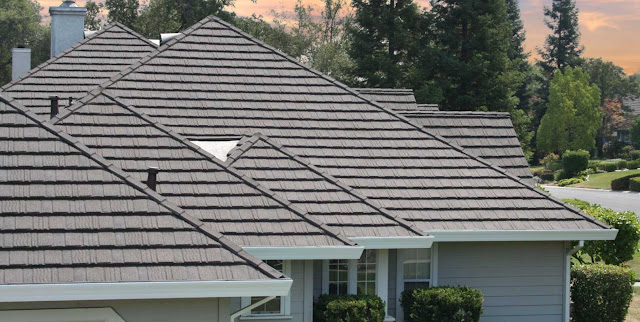The material of a roof may range from banana leaves, wheaten straw or seagrass to laminated glass, copper (see: copper roofing), aluminium sheeting and pre-cast concrete. In many parts of the world ceramic roof tiles have been the predominant roofing material for centuries, if not millennia.
Other roofing materials include asphalt, coal tar pitch, EPDM rubber, Hypalon, polyurethane foam, PVC, slate, Teflon fabric, TPO, and wood shakes and shingles.
>> Related Post: Top 5 common types of office roofing.
The construction of a roof is determined by its method of support and how the underneath space is bridged and whether or not the roof is pitched. The pitch is the angle at which the roof rises from its lowest to highest point.
Most US domestic architecture, except in very dry regions, has roofs that are sloped, or pitched. Although modern construction elements such as drainpipes may remove the need for pitch, roofs are pitched for reasons of tradition and aesthetics.
So the pitch is partly dependent upon stylistic factors, and partially to do with practicalities.
1. How do you clean your roof?
A roof usually works without having to be cleaned. Cleaning will be uncommon if your roof is prone to moss or other growth.
Metal roofing company Austin suggests applying a garden sprayer full of bleach and water to damaged areas. Rinsing from above keeps water out of shingles.
Caution is advised as a wet roof may turn slick. Do not use a power washer on a roof, and scrubbing is also not recommended.
A roof is the top covering of a building, including all materials and constructions necessary to support it on the walls of the building or on uprights, providing protection against rain, snow, sunlight, extremes of temperature, and wind. A roof is part of the building envelope.
The characteristics of a roof are dependent upon the purpose of the building that it covers, the available roofing materials and the local traditions of construction and wider concepts of architectural design and practice and may also be governed by local or national legislation.
In most countries a roof protects primarily against rain. A verandah may be roofed with material that protects against sunlight but admits the other elements. The roof of a garden conservatory protects plants from cold, wind, and rain, but admits light.
A roof may also provide additional living space, for example, a roof garden.
>> Related Post: Does My Roofing Services Need An Insurance?
2. How to know if a roof is installed correctly?
Inspect the roof thoroughly after being installed by a metal roofing company in Austin. If not, they should have replaced them—new flashing around chimneys and valleys.
The roof should be visually uniform in color and have clear straight lines.
The shape of roofs differs greatly from region to region. The main factors which influence the shape of roofs are the climate and the materials available for roof structure and the outer covering.
The basic shapes of roofs are flat, mono-pitched, gabled, mansard, hipped, butterfly, arched and domed. There are many variations on these types. Roofs constructed of flat sections that are sloped are referred to as pitched roofs (generally if the angle exceeds 10 degrees).
Pitched roofs, including gabled, hipped and skillion roofs, make up the greatest number of domestic roofs. Some roofs follow organic shapes, either by architectural design or because a flexible material such as thatch has been used in the construction.
>> Related Post: Does Repairing Cost More Than Replacing My Roof?
3. How long do roofs typically last?
A neglected asphalt shingle roof will last 15 years. In moderate climates, 10–15 years, while metal and slate roofs may endure 50 years or more.
Weather is the most important aspect, and even a well-installed roof may be damaged by wind and sun.
Metal roofing company Austin suggests avoiding letting tree limbs contact the ceiling and removing dead ones.
A roof assembly has more than one function. It may provide any or all of the following functions:
To shed water i.e., prevent water from standing on the roof surface. Water standing on the roof surface increases the live load on the roof structure, which is a safety issue. Standing water also contributes to premature deterioration of most roofing materials. Some roofing manufacturers' warranties are rendered void due to standing water.
To protect the building interior from the effects of weather elements such as rain, wind, sun, heat and snow.
>> Related Post: What To Look For When Choosing A Roofing Contractor?
To provide thermal insulation. Most modern commercial/industrial roof assemblies incorporate insulation boards or batt insulation. In most cases, the International Building Code and International Residential Code establish the minimum R-value required within the roof assembly.
To perform for the expected service life. All standard roofing materials have established histories of their respective longevity, based on anecdotal evidence. Most roof materials will last long after the manufacturer's warranty has expired, given adequate ongoing maintenance, and absent storm damage. Metal and tile roofs may last fifty years or more. Asphalt shingles may last 30–50 years. Coal tar built-up roofs may last forty or more years. Single-ply roofs may last twenty or more years.
Provide a desired, unblemished appearance. Some roofs are selected not only for the above functions, but also for aesthetics, similar to wall cladding. Premium prices are often paid for certain systems because of their attractive appearance and "curb appeal."
Conclusion
Swadley Roof Systems offers the best roofing services in the Houston, Austin, San Antonio and Dallas area.
- Tel: 832-559-8463
- Email: info@swadleyroofsystems.com
- Location: 17413 FM 2920 Suite O Tomball, TX 77377
- Facebook: Fanpage Swadley Roof Systems
- Website: https://www.swadleyroofsystems.com/







0 Comments
Đăng nhận xét